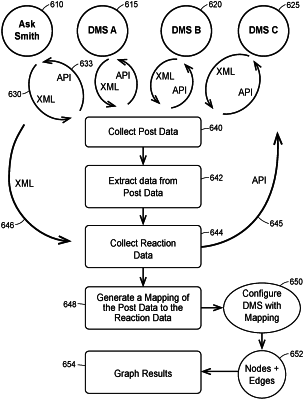| CPC G06F 16/93 (2019.01) [G06F 16/27 (2019.01); G06F 16/904 (2019.01); G06F 16/907 (2019.01); G06F 17/40 (2013.01)] | 20 Claims |

|
1. A computer system for generating a graphical representation of a mapping of post data of a posting, the computer system comprising one or more processors and a memory configured to store instructions, the instructions executed by the one or more processors to cause the computer system to:
collect the post data from one or more document management systems, the post data including a first node of a plurality of nodes identifying a submitting user of the one or more document management systems that submitted the posting to the one or more document management systems;
collect reaction data from the one or more document management systems, wherein the reaction data is associated with the posting and the reaction data further including a second node of the plurality of nodes identifying a reacting user of the one or more document management systems that reacted to the posting;
periodically generate the mapping of the post data to the reaction data, wherein the mapping includes the first node of the plurality of nodes and the second node of the plurality of nodes; and
generate the graphical representation of the mapping, wherein zooming out of the graphical representation filters out one or more nodes of the plurality of nodes based on a number of edges corresponding to the one or more nodes, and wherein the one or more nodes reappear on the graphical representation in response to zooming in on the graphical representation.
|